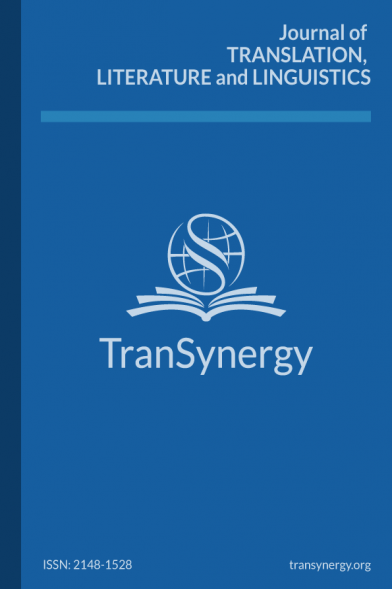Translating Secondary World Infrastructures: Re-creating the World-Building of Semley’s Necklace
Secondary world infrastructures serve as the foundation of imaginary world-building through which authors of science fiction and fantasy craft complete, coherent, and plausible worlds. This study explores the translation of these infrastructures in science fiction and fantasy genres, specifically focusing on the story Semley's Necklace by Le Guin and its translations into Turkish. Drawing upon Venuti's approach to the visibility of translator/translation and Wolf's framework for world-building, the paper argues that translating such an intricately structured world, laden with its myriad elements, into an alternate language entails a process akin to reconstructing or reimagining it in its entirety. In line with this, employing a foreignizing approach 'to stage an alien reading experience’ (Venuti,1995, p.20) aligns with the foreignization objective of world-building, which can be understood as convincing the reader of the otherness of the imaginary world. Through a comparative analysis of two Turkish translations, the study examines how effectively these versions convey the world-building elements of the source text. The findings revealed contrasting approaches employed by the translators: Çele predominantly opted for domestication, minimizing the reader's cognitive effort in navigating the unfamiliar. Conversely, Babacan embraced a foreignizing approach, preserving lexical nuances and cultural specificity within the descriptions of world-building tools comprising the infrastructures. Hence, understanding the translator's choices deepens our understanding of how readers experience and interpret an imaginary world of fantasy and science fiction, highlighting the role of translation in shaping literary reception.
Translating Secondary World Infrastructures: Re-creating the World-Building of Semley’s Necklace
Secondary world infrastructures serve as the foundation of imaginary world-building through which authors of science fiction and fantasy craft complete, coherent, and plausible worlds. This study explores the translation of these infrastructures in science fiction and fantasy genres, specifically focusing on the story Semley's Necklace by Le Guin and its translations into Turkish. Drawing upon Venuti's approach to the visibility of translator/translation and Wolf's framework for world-building, the paper argues that translating such an intricately structured world, laden with its myriad elements, into an alternate language entails a process akin to reconstructing or reimagining it in its entirety. In line with this, employing a foreignizing approach 'to stage an alien reading experience’ (Venuti,1995, p.20) aligns with the foreignization objective of world-building, which can be understood as convincing the reader of the otherness of the imaginary world. Through a comparative analysis of two Turkish translations, the study examines how effectively these versions convey the world-building elements of the source text. The findings revealed contrasting approaches employed by the translators: Çele predominantly opted for domestication, minimizing the reader's cognitive effort in navigating the unfamiliar. Conversely, Babacan embraced a foreignizing approach, preserving lexical nuances and cultural specificity within the descriptions of world-building tools comprising the infrastructures. Hence, understanding the translator's choices deepens our understanding of how readers experience and interpret an imaginary world of fantasy and science fiction, highlighting the role of translation in shaping literary reception.
___
Britannica Online. (n.d.). Time dilation. https://www.britannica.com/science/time-dilation
Campbell, I. (2021). Introduction: Science fiction and translation. In I. Campbell (Ed.), Science fiction in translation: Studies in global science fiction (pp. 1-18). Palgrave Macmillan, Cham.
Carpenter, H., & Tolkien, C. (2019). The Letters of J. R. R. Tolkien. HarperCollins.
Cummins, E. (1993). Understanding Ursula K. Le Guin. University of South Carolina Press.
Farhati, A., & Hadiyanto, H. (2021). Feudalism in the abuse of power in Ursula K. Le Guin's Semley's necklace. Culturalistics: Journal of Cultural, Literary and Linguistic Studies, 5(1), 1-9. https://doi.org/10.14710/culturalistics.v5i1.10156
Le Guin, U. K. (1995). Rocannon'un Dünyası. Metis.
Le Guin, U. K. (2015). Semley'in Kolyesi. In R. Le Guin, Rüzgar'ın On İki Köşesi (2nd ed., pp. 389-511). Ayrıntı.
Le Guin, U. K. (1966). Rocannon's World. Ace Books.
Stockwell, P. (2006). Invented language in literature. In K. Brown et al. (Eds.), Encyclopedia of Language & Linguistics (Vol. 6, pp. 3-10). Elsevier Science.
Venuti, L. (1995). The translator's invisibility: A history of translation. Routledge.
Wan, S. Y. C., & Amini, M. (2020). Secondary world infrastructures and storyworld of the Little Prince novella. Pertanika Journal of Social Science & Humanities, 28(1), 175-189.
Wardhaugh, R., & Fuller, J. M. (2021). An Introduction to Sociolinguistics. Hoboken, NJ: Wiley Blackwell.
Wolf, M., & J., P. (2012). Building imaginary worlds: The theory and history of subcreation. Routledge.
